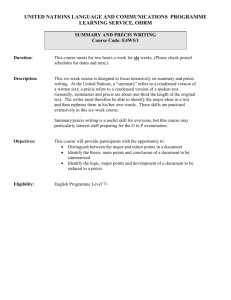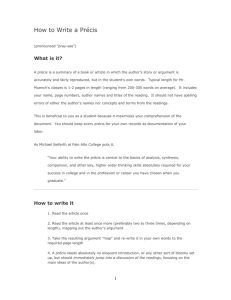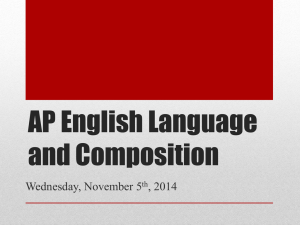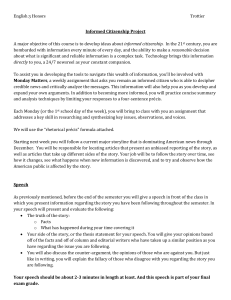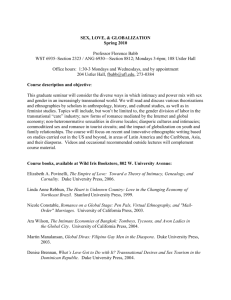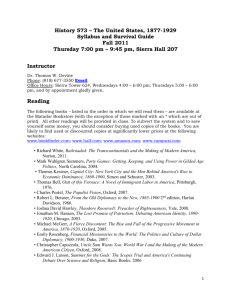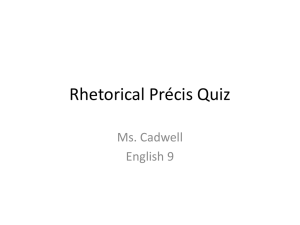Biol 484 – Plant Evolution Fall 2012
advertisement
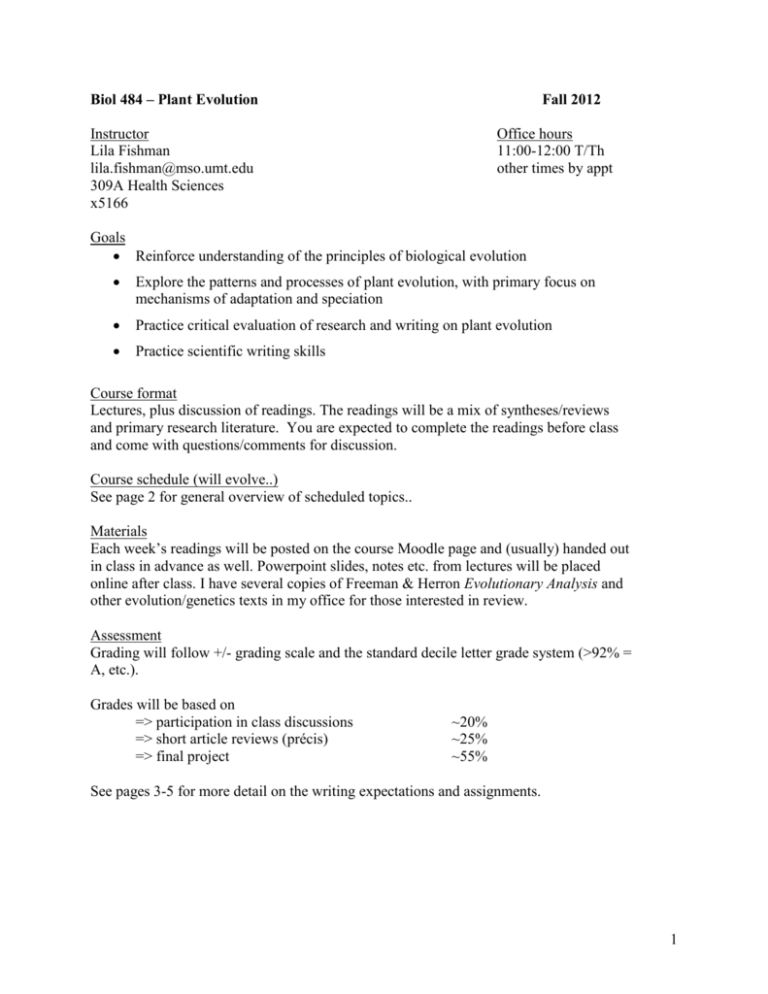
Biol 484 – Plant Evolution Fall 2012 Instructor Lila Fishman lila.fishman@mso.umt.edu 309A Health Sciences x5166 Office hours 11:00-12:00 T/Th other times by appt Goals Reinforce understanding of the principles of biological evolution Explore the patterns and processes of plant evolution, with primary focus on mechanisms of adaptation and speciation Practice critical evaluation of research and writing on plant evolution Practice scientific writing skills Course format Lectures, plus discussion of readings. The readings will be a mix of syntheses/reviews and primary research literature. You are expected to complete the readings before class and come with questions/comments for discussion. Course schedule (will evolve..) See page 2 for general overview of scheduled topics.. Materials Each week’s readings will be posted on the course Moodle page and (usually) handed out in class in advance as well. Powerpoint slides, notes etc. from lectures will be placed online after class. I have several copies of Freeman & Herron Evolutionary Analysis and other evolution/genetics texts in my office for those interested in review. Assessment Grading will follow +/- grading scale and the standard decile letter grade system (>92% = A, etc.). Grades will be based on => participation in class discussions => short article reviews (précis) => final project ~20% ~25% ~55% See pages 3-5 for more detail on the writing expectations and assignments. 1 Fall 2012 -- BIOL484 SCHEDULE WEEK DATE TOPIC 8/28 Week 1 Intro to Course 8/30 Broad patterns in plant evolution Week 2 9/04 9/06 Week 3 9/11 9/13 Week 4 9/18 9/20 Week 5 9/25 9/27 Week 6 10/02 10/04 Week 7 10/09 10/11 Week 8 10/16 10/18 Week 9 10/23 10/25 Week 10 10/30 11/01 Week 11 11/06 11/12 Week 12 11/13 11/15 Week 13 11/20 11/22 Week 14 Review: Population Genetics Ch. 1-3, C&H (pdfs) plus articles Review: Quantitative Genetics Ch. 4-6, C&H (pdfs) plus articles Guest Lecture? Abiotic Adaptation articles Biotic Adaptation & Coevolution NO CLASS – GO VOTE!!!! Speciation & Adaptive Radiation THANKSGIVING HOLIDAY 11/27 11/29 Week 15 READINGS Student Presentations 12/03 12/05 Final Week Final Paper Due – Wed. Dec. 12th C&H = Conner & Hartl’s “Primer of Ecological Genetics”. You can purchase this text as a paperback online, but I will provide pdfs/hard copies of the chapters we will be using. 2 Writing outcomes and expectations - overview Critical reading and synthesis of the primary literature is key to learning how to write effectively about biology, as well as to gaining conceptual/factual mastery of the field. We will use several different types of activities to practice reading and writing skills. Weekly readings -- Each week, we will read at least one scientific journal article and discuss it in detail during class-time. You are expected to read the assigned articles prior to class, and to come prepared to participate with at least one question or comment. No question is "too basic" -- the goal here is participation! Précis reviews -- You will complete 5 "précis" reviews (1 page max, single-spaced) of assigned research articles during the semester. A précis is a critical synopsis, not merely a summary of content (see Précis handout for more details on format, goals and evaluation). In addition to enhancing knowledge of the research topics and critical thinking skills, this activity is designed to encourage efficient reading and writing through repeated practice. Final Project -- The majority of your grade will be based on a research project on a topic of your choosing (within the scope of the course). This project includes multiple graded components (see attached handouts for details of the Presentation and Paper components). Final Project -- Process and grading 1. Meet with me to discuss topic (week 9) 2. Submit 1/2 page outline of paper (week 10) 3. Draft paper due (week 12) 4. Receive comments/feedback (week 13-14) 5. 15 minute presentation (weeks14-15) 6. Final paper due (day of Final exam) 5% 15% 15% 20% 55% of course grade As a Writing Course, a primary goal of this class is training in the process of scientific writing, which generally involves multiple rounds of revision. Therefore, you will have the opportunity to revise your final paper in response to feedback on your outline, first draft, and in-class presentation. These preliminary components and the Final Paper will be evaluated on the basis of both structure and content (Does it do the things outlined on the handout well? Is is accurate, complete and insightful?). Specific writing outcomes of the précis and paper assignments include the ability to: use writing to synthesize concepts formulate and express hypotheses and alternatives find, evaluate, and integrate biological information from diverse sources effectively compose written documents appropriate for a given audience/purpose use scientific writing conventions (e.g., citations, scientific names) revise writen work in response to constructive feedback demonstrate appropriate English usage, including grammar, spelling, and paragraph construction Please note: You are bound by the University of Montana student conduct code. All written work turned in for credit must be solely your work AND may not have been used for credit in another course. Plagiarism and cheating of any kind will result in referral for disciplinary action and you will receive a 3 zero on the assignment. This will significantly impact your final course grade. 4 BIOL 484 – Plant Evolution Writing a Précis of a Research Communication Being able to summarize and criticize scientific literature is essential to your success as a student or professional scientist. The goals listed below should be in mind whenever you read an article from the primary scientific literature. To practice applying them, you will write a brief summary paper (a précis) addressing these goals for many of the articles we read. Strictly speaking, a “précis” is a brief summary and critical evaluation of the text under consideration. In writing a précis of a research article, your goals are: (1) to identify the hypotheses being tested (including alternatives) – this generally includes both BIG QUESTIONS and more specific ones (2) to indicate why they are being tested – i.e., what observations and/or theory motivate the authors (3) to summarize succinctly the methods employed and results obtained – focus on the overall approach and key findings rather than the details (details can matter a great deal, but at this stage is better to get the big picture) (4) to show how these results do or do not address the hypotheses under investigation. (5) to evaluate whether the methods used are appropriate to testing the hypotheses and whether the results convincingly support the authors’ conclusions. You are not expected to evaluate the methods with a specialist’s eye –focus on whether or not the experimental approaches rule out alternative hypotheses, whether there may be confounding factors unconsidered, etc. For papers in this class, a précis should be no less than 300 words and no more than 500 words long, i.e., up to a page of text single-spaced (1-2 paragraphs). Hallmarks of a good précis are conciseness, clarity of exposition, and insight into the assumptions, limitations and merits of the text under review. The précis assignments will be graded on both content and presentation (i.e., correct spelling, punctuation and grammar, as well as sentence and paragraph structure) on a 10 point scale. 5 Biology 484 Plant Evolution Final Projects The goal of this exercise is for you to think deeply about a particular problem in plant evolution, summarize the current theory and existing empirical data relevant to your chosen issue, and propose a program of research to address remaining questions. Problems may range from the broad (“Why has sex evolved?”) to the relatively specific (“Why do whitebark pine trees make lots of cones some years and few in others?”). Generally speaking, these will be “why?” questions. Particularly for the last goal, it will be useful to concentrate on a particular system (i.e., propose experiment/studies following up on published work). Choose a question/system you are interested in!! *Note: It is acceptable (and even wise) to “double-up” on the background reading/research for another project in another class. For example, if you have been reading a lot about the physiology of drought tolerance for another course, choosing to write your BIOL484 paper on the evolution of drought tolerance would be fine. However, you must address a significant (and general) evolutionary question relevant to the topic AND any work turned in for credit may not overlap substantially in content/wording with work also submitted for any other class past or present. Such plagiarism is not acceptable and will result in a ZERO grade on the assignment. You will be graded on 4 components of the final project: an outline, a first draft, a presentation, and a final paper. Outline: bullet list of the anticipated content in each section of the paper, including 3 key refs. Presentation: ~15 minutes during the last 2 weeks of class-time (see page 6 for details) Paper: 8 pages double-spaced (maximum), 8+ references. The format of the paper will be similar to a research proposal, but with more emphasis on the background sections rather than the proposed work, methods etc. Broad outline 1st page – frame question broadly and concisely => Why is this an important problem? => What do we already know? What are gaps in knowledge? p. 2-5 -- Expand background/ review prior research on topic p. 6-8 – Describe future research program designed to answer main question Depending on how specific your topic is, you will almost certainly also need to describe the biological system and discuss why it is a good one for addressing the question. We will go over in class (and in our 1-on-1 meeting) strategies for finding key references using online databases, defining important gaps in knowledge, organizing your background information, etc. etc. I will provide detailed feedback on the first draft, which is worth nearly as many points as the final draft, and you will have the opportunity to revise. 6 Biol484: Plant Evolution Final Presentations The presentations are an opportunity to share your topic with the rest of the class and get feedback for revising your paper. Format: 12-15 minutes + 5 minutes for questions Use Powerpoint. Plan on ~10-18 slides. Resist the impulse to add animations, sound, etc. unless they substantially and directly address your points (e.g. a video of pollinators may be a good use of time, a random cartoon is probably not). You can choose “blank presentation” or use a template with titles etc., but please do not use the fancy backgrounds etc. as they are distracting. 1. Introduce the general question/problem/topic. 1-2 slides. 2. Provide background, summarize other’s research. Describe general patterns, competing theories, etc. This will probably include several case studies with brief synopses and images (photos, results). It is OK to copy figures (use photo-select in Adobe) directly from papers as long as you give credit. This will be the bulk of the presentation: 4-8 slides (go low if wordy) 3. Define the specific question/system for your proposal. This will generally be narrower than the general topic (not always) and should lead to testable evolutionary hypotheses. 1-2 slides. 4. Describe an experimental study or studies that will allow you to distinguish among your alternative hypotheses. 1-2 slides. 5. Describe potential outcomes and their interpretation. That is, if you think that X trait difference between populations is due to local adaptation to Y conditions, show how data consistent (and not) with that hypothesis would look. 1-2 slides. 6. Conclude / look forward/ describe broader implications. This will depend on your topic, but it’s nice to reiterate key points and wrap things up with a broader statement. 1 slide. You do not need a citations slide at the end, but should reference any specific research described or pictured on the relevant slide, as well as verbally (" so & so, in a 1998 paper, found x y and z"). Please don’t say only “people found y ” or “they think x” – be specific about who said what. Presentations will be graded on both content and structure (Does the line of reasoning make sense? Is appropriate background presented?), with clarity as the primary criterion. 7 BIOL484: Plant Evolution Week Section 1: Broad patterns Learning Outcomes 1 Overview of land plant phylogeny and taxonomy - characterize the order/timing of major transitions in plant evolution and associations with plant species diversity Major transitions - describe the broad significance of key traits defining major plant groups for their ecology and evolution Week Section 2: Population Genetics Learning Outcomes 2 mutation - define the four evolutionary forces and qualitatively describe their relative magnitudes, dependencies (i.e., drift depends on effective population size), and general effects on population variation (i.e. drift decreases variation at all loci) drift and effective population size 3 migration and population structure selection mutation-selection, migration-selection, migration-drift balance - qualitatively characterize the outcomes of interactions between evolutionary forces - describe the use of molecular markers to estimate population genetic and ecological parameters in plants, often for conservation purposes - describe the effects of inbreeding (and other forms of assortative mating) on the distribution of genetic variation within and among plant populations Inbreeding and assortative mating Week Section 3: Quantitative Genetics Learning Outcomes 4 Narrow and broadsense heritability - understand why not all genetically-based phenotypic variation is heritable Plasticity, GxE, Correlations 5 - describe the conseqeunces of positive and negative genetic correlations - apply experimental methods for characterizing genetic variances and covariances Phenotypic variation – Is it genetic? Is it adaptive? - apply methods for measuring selection Phenotypic selection - describe the molecular basis and evolutionary consequences of linkage among loci Linkage and linkage disequilibrium Genetic mapping - describe how the genetic basis of current differences reveals the mode and tempo of past evolution - critically evaluate current research into plant variation and adaptation using genetic and genomic approaches Week Section 4: Abiotic adaptation Learning Outcomes 6 Edaphic adaptation -identify major axes of environmental variation shaping plant diversity Life history variation - define and provide examples of physiological and evolutionary tradeoffs Phenology and climate change - describe major plant life history strategies and their environmental distributions Water stress and - critically evaluate current research on plant abiotic adaptation, particularly 7 8 8 photosynthesis with regard to responses to climate change Week Section 5: Biotic adaptation and coevolution Learning Outcomes 9 Mating system evolution -describe broad associations between plant ecology, floral morphology, and pollinating taxa Pollination syndromes 10 Seed dispersal Herbivory and disease 11 Symbiosis Competition and cooperation with other plants -characterize the incidence, origins, and evolutionary/ecological consequences of self-fertilization in plants - characterize costs and benefits of propagule dispersal - provide examples of both antagonistic and mutualistic coevolution in plants - critically evaluate research on plant coevolutionary interactions with other organisms Week Section 6: Speciation and radiation Learning Outcomes 12 Geographical context -characterize both historical and current perspectives on the problem of speciation Reproductive isolation 13 14 Hybrid zones and hybrid speciation Chromosomal evolution and polyploidy Adaptive radiation -describe multiple models, with examples, for the evolution of postzygotic reproductive isolation -understand the importance of karotypic evolution and polyploidy for plant speciation -explain major models for adaptive radiation in plants -critically evaluate research on plant speciation 9
